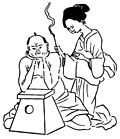What’s that funny smell? Seriously…it’s not pot!!

I use tons of moxa in my office and as the days get colder the amount will continue to increase. This leads to a particular dilemma; mugwort, the common name for the herb used in moxibustion smells very similar to pot. New patients will come in and quickly give me an odd look as if to say, “Is the guy that’s about to put needles in me high?” No, not high at all, just using an ancient herb that has been around even longer than acupunct ure. Moxibustion is an important component of Chinese medicine and predates the stone age. As early as the discovery of fire primitive man would warm himself by the fire to reduce pain in “cold” parts of his body. Before the use of mugwort (Artemisia vulgaris, moxa) burnt hot stone or sand was wrapped in bark or animal skin to make a warm compress. This evolved into igniting bundles of branches or hay to treat diseased areas. Mugwort was found to be the herb with the most effective heat retaining properties and comes from the fuzz found on the underpart of the mugwort leaf. All of the mugwort used today comes from the moxa plants in China and is aged for seven years before it is considered to be good enough for use in moxibustion.
ure. Moxibustion is an important component of Chinese medicine and predates the stone age. As early as the discovery of fire primitive man would warm himself by the fire to reduce pain in “cold” parts of his body. Before the use of mugwort (Artemisia vulgaris, moxa) burnt hot stone or sand was wrapped in bark or animal skin to make a warm compress. This evolved into igniting bundles of branches or hay to treat diseased areas. Mugwort was found to be the herb with the most effective heat retaining properties and comes from the fuzz found on the underpart of the mugwort leaf. All of the mugwort used today comes from the moxa plants in China and is aged for seven years before it is considered to be good enough for use in moxibustion.
So how does moxibustion work? By bringing heat to the acupuncture points, the channels (meridians) of qi are opened allowing the body’s healing processes to function better and more quickly. The body becomes more relaxed, pain is relieved and blood circulation improves as the warmth penetrates muscles, tendons and bones. Typically moxibustion therapy is used in TCM for conditions of cold and stagnation of qi. The moxa is made into rolls, ignited and placed either directly over the skin or over the top of the needles. Moxibustion is often used for the treatment of a weak immune system, kidney failure, frequent urination, chronic pain, poor appetite and digestion. It has been found to be particularly helpful in childbirth to turn breeched babies.